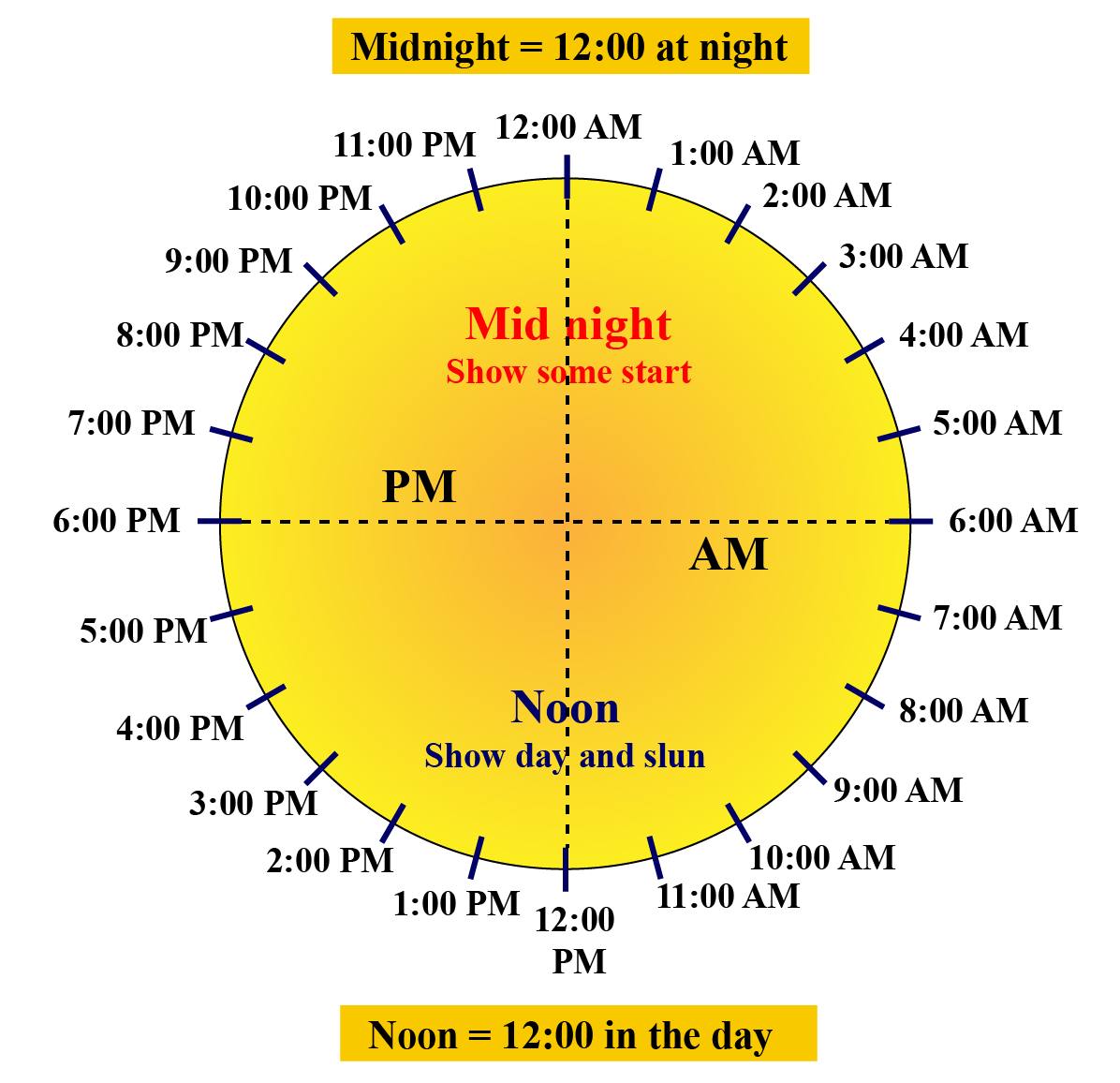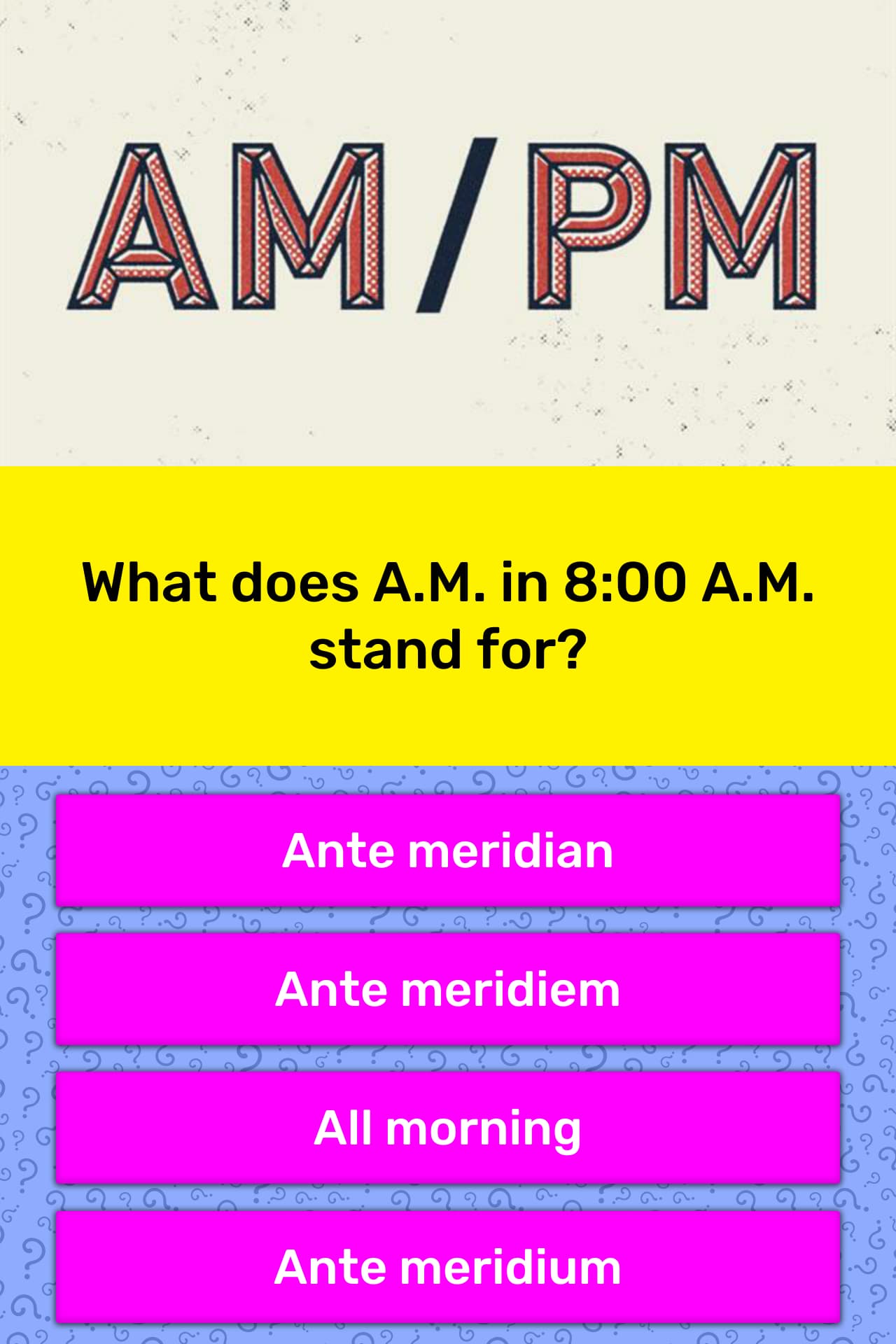
Do you know what the abbreviation "am" stands for? The answer is "ante meridian." Ante meridian is a Latin term that means "before noon." In other words, "am" refers to the time between midnight and noon.
Origins of Ante Meridian

The concept of dividing the day into two periods, "am" and "pm," dates back to ancient Rome. The Romans used a system of twelve hours to measure time, starting at sunrise and ending at sunset. However, as the length of the day varied throughout the year, the length of each hour also varied. This made timekeeping difficult and imprecise.
In the Middle Ages, a new system of timekeeping was developed. This system divided the day into twenty-four hours of equal length, with twelve hours of daylight and twelve hours of darkness. This system was based on the position of the sun and was more accurate than the Roman system.
AM vs. PM

The terms "am" and "pm" are used to distinguish between the two halves of the day. "Am" refers to the period between midnight and noon, while "pm" refers to the period between noon and midnight.
The use of "am" and "pm" is particularly important in the 12-hour clock system, which is used in the United States and other countries. In this system, the hours are numbered from 1 to 12, with 12 indicating noon or midnight. The use of "am" and "pm" helps to avoid confusion between the two.
AM in Everyday Life
The abbreviation "am" is used in a variety of contexts in everyday life. For example, it is commonly used on alarm clocks and other timekeeping devices to indicate the time of day. It is also used on schedules, calendars, and other documents to indicate the time of an event or appointment.
In addition, "am" is often used in business and professional settings to indicate the start of the workday. For example, a business might be open from 9:00 am to 5:00 pm, which means that it is open from 9:00 in the morning until 5:00 in the evening.
Conclusion

Now you know what the abbreviation "am" stands for. It refers to the period between midnight and noon, or "ante meridian" in Latin. The use of "am" and "pm" helps to distinguish between the two halves of the day and is particularly important in the 12-hour clock system.
Related video of Am Stands For Ante Meridian

Introduction
AM PM is a common term that we use in our daily lives, particularly while referring to time. However, not everyone is aware of what it means or its full form. In this article, we will discuss the AM PM full form and its usage.
What is AM?

AM stands for Ante Meridiem, which is a Latin term that means "before noon." It is used to refer to the time between midnight and noon. In the 12-hour clock system, the time between 12:00 midnight and 12:00 noon is referred to as AM.
What is PM?

PM stands for Post Meridiem, which is a Latin term that means "after noon." It is used to refer to the time between noon and midnight. In the 12-hour clock system, the time between 12:00 noon and 12:00 midnight is referred to as PM.
History of AM PM

The use of AM PM can be traced back to the early Roman Empire, where the day was divided into 12 hours of daylight and 12 hours of darkness. However, it was the Egyptians who first divided the day into 24 hours. The use of AM PM became popular in the 16th century when mechanical clocks were invented.
Usage of AM PM

The 12-hour clock system is widely used in the United States, Canada, and other English-speaking countries. In these countries, people use AM PM to distinguish between the time of day. For example, 3:00 PM means three o'clock in the afternoon, while 3:00 AM means three o'clock in the morning.
Advantages of AM PM

The use of AM PM is beneficial, particularly for people who are not familiar with the 24-hour clock system. It helps people to distinguish between morning and evening hours easily. The 12-hour clock system is also useful for scheduling appointments, meetings, and events.
Disadvantages of AM PM

The 12-hour clock system has some disadvantages as well. It can be confusing for people who are not familiar with it, particularly when they travel to countries that use the 24-hour clock system. Moreover, the use of AM and PM can also lead to miscommunication, especially in a globalized world where people from different countries and cultures interact frequently.
How to Convert AM PM to 24-hour Clock System

Converting AM PM to the 24-hour clock system is quite simple. To convert AM to the 24-hour clock system, you need to add 12 to the hour. For example, 9:00 AM would be 09:00 in the 24-hour clock system. To convert PM to the 24-hour clock system, you need to add 12 to the hour as well. For example, 3:00 PM would be 15:00 in the 24-hour clock system.
Conclusion
AM PM is a widely used term that helps people to distinguish between morning and evening hours. It is essential to understand its full form and usage, particularly in countries that use the 12-hour clock system. Although it has some advantages, it also has some disadvantages. Therefore, it is essential to be familiar with the 24-hour clock system as well to avoid miscommunication.
Related video of What is the Full Form of AM and PM?

Introduction
If you've ever looked at a clock, you've probably seen the letters "AM" and "PM." But what do they stand for, and why are they important? In this article, we'll explore the origins of these time abbreviations and how they're used in everyday life.
What Does AM Stand For?

The letters "AM" stand for "ante meridiem," which is Latin for "before noon." This means that any time between midnight and noon is considered AM. For example, 1:00 AM is one hour after midnight, and 11:00 AM is one hour before noon.
What Does PM Stand For?

The letters "PM" stand for "post meridiem," which is Latin for "after noon." This means that any time between noon and midnight is considered PM. For example, 1:00 PM is one hour after noon, and 11:00 PM is one hour before midnight.
Why Are AM and PM Important?

AM and PM are important because they help us distinguish between the different parts of the day. For example, if you tell someone to meet you at 2:00, they might not know whether you mean 2:00 in the morning or 2:00 in the afternoon. But if you say "2:00 PM," they'll know that you mean 2:00 in the afternoon.
How Are AM and PM Used in Everyday Life?

AM and PM are used in a variety of ways in everyday life. For example, when you make an appointment with your doctor or dentist, they'll usually ask you whether you prefer a morning or afternoon appointment. This is because they need to know whether to schedule you for an AM or PM appointment.
Is There a 24-Hour Clock?

Yes, there is a 24-hour clock, which is also known as "military time." Instead of AM and PM, the 24-hour clock uses numbers to indicate the time. For example, 1:00 AM would be written as 01:00, and 1:00 PM would be written as 13:00. The 24-hour clock is often used in the military, transportation, and other industries where precise timing is important.
Conclusion
Now that you know what AM and PM stand for, you can use them to communicate more effectively with others. Whether you're scheduling an appointment, catching a flight, or just trying to figure out what time it is, understanding the difference between AM and PM is an important part of everyday life.
Related video of Am and Pm: What Do They Stand For?

Alvin and the Chipmunks, a popular American media franchise, is known for its animated music videos and movies. One of their most famous songs is the Christmas song, which has become a holiday staple for many families. The song was first introduced in the 1960s, and since then, it has been remade and covered by various artists.
Origin of the Song

The original Christmas song was written by Ross Bagdasarian Sr., who was also the creator of Alvin and the Chipmunks. The song was released in 1958 as a single, and it quickly became popular among listeners. The song features the high-pitched voices of the Chipmunks, which is achieved by speeding up the recording.
Movie Adaptation

In 2007, a live-action/CGI film adaptation of Alvin and the Chipmunks was released, which included a rendition of the Christmas song. The song was performed by the Chipmunks and the Chipettes, who are the female counterparts of the Chipmunks. The movie was a commercial success, and it spawned several sequels.
Popularity
The Christmas song has become a holiday favorite for many families worldwide. The song's popularity has led to its inclusion in various Christmas albums and movies. It has also been covered by many artists, including Celine Dion, Mariah Carey, and Pentatonix.
Lyrics

The lyrics of the Christmas song are simple and easy to remember. The chorus goes:
"Christmas, Christmas time is near
Time for toys and time for cheer
We've been good, but we can't last
Hurry Christmas, hurry fast"
The song goes on to describe the excitement and anticipation of Christmas, and it ends with the Chipmunks wishing everyone a Merry Christmas.
In Conclusion
The Alvin and the Chipmunks Christmas song has become a holiday classic that is enjoyed by people of all ages. Its catchy tune and simple lyrics make it easy to sing along, and it has become a staple of many Christmas celebrations. Whether you're watching the movie or listening to the song on the radio, the Chipmunks' rendition of the Christmas song is sure to bring a smile to your face.
Related video of Alvin And The Chipmunks Movie Christmas Song

Alternators are an essential part of any vehicle's electrical system. They are responsible for generating electricity that powers all of the vehicle's electrical components. One of the most common questions asked about alternators is whether they output AC or DC voltage. In this article, we will explore the difference between AC and DC output and how it affects the performance of your vehicle.
What is Alternator Output?
The output of an alternator is the electrical energy that it generates. This energy is measured in volts and is used to power the various electrical components of the vehicle. The alternator output is regulated by the voltage regulator, which ensures that the output stays within a certain range.
AC Output

AC stands for alternating current. Alternating current output means that the voltage generated by the alternator changes polarity at regular intervals. This type of output is commonly found in older vehicles that have a generator instead of an alternator. AC output is not commonly used in modern vehicles.
DC Output

DC stands for direct current. Direct current output means that the voltage generated by the alternator flows in one direction only. This type of output is commonly found in modern vehicles that use an alternator. DC output is more efficient than AC output and is preferred for powering modern electrical components.
Advantages of DC Output

DC output has several advantages over AC output. First, it is more efficient, which means that it can generate more power with less energy. Second, it is easier to convert to the voltage and current levels required by modern electrical components. Finally, it is more reliable because it is less affected by electrical noise and interference.
Alternator Diode Rectifier
The alternator diode rectifier is a component that converts AC output to DC output. It is composed of several diodes that are connected in a specific pattern. The diodes allow the electrical current to flow in one direction only, which converts the AC output to DC output. The diode rectifier is an essential part of the alternator and must be functioning correctly for the vehicle's electrical system to operate correctly.
How to Test Alternator Output
To test the output of an alternator, you will need a voltmeter. The voltmeter should be connected to the battery while the vehicle is running. The alternator output should be between 13.5 and 14.5 volts. If the voltage is below this range, it may indicate a problem with the alternator or the voltage regulator.
Conclusion
Alternator output is an essential aspect of any vehicle's electrical system. The output can be either AC or DC, with DC being the preferred type for modern vehicles. The alternator diode rectifier is a critical component that converts AC output to DC output. Testing the output of the alternator is a simple process that can help diagnose problems with the electrical system. By understanding the output of your alternator, you can ensure that your vehicle's electrical components operate correctly and efficiently.
Related video of Alternator Output AC or DC
When it comes to the English language, the alphabet is the foundation. The alphabet consists of 26 letters, and each letter has its own unique sound. These letters are divided into two categories: vowels and consonants.
What are Vowels?

Vowels are the letters A, E, I, O, U, and sometimes Y. These letters have a sound that is produced without any obstruction in the mouth or throat. When you say a vowel, your mouth is open and your tongue is in a neutral position.
The letter Y is sometimes considered a vowel because it can function as a vowel in some words, such as "myth" and "gym." In these words, the Y makes a sound like a long I or a long E.
What are Consonants?

Consonants are all the other letters of the alphabet that are not vowels. These letters have a sound that is produced with some kind of obstruction in the mouth or throat. When you say a consonant, your mouth is partially or completely closed, and your tongue or lips create the obstruction that produces the sound.
There are many different types of consonants, including plosives, fricatives, affricates, nasals, and more. Each type of consonant is produced in a slightly different way and has a different sound.
Why are Vowels and Consonants Important?

Vowels and consonants are important because they are the building blocks of words. Without vowels and consonants, we wouldn't be able to communicate using written or spoken language.
Vowels and consonants also play an important role in the English language. For example, vowels are often used to indicate stress or emphasis in a word. Consonants can also change the meaning of a word. For example, the word "cat" becomes "bat" if you change the first consonant.
How to Identify Vowels and Consonants

Identifying vowels and consonants is easy once you know the difference between the two. To identify a vowel, look for the letters A, E, I, O, U, and sometimes Y. To identify a consonant, look for all the other letters of the alphabet.
It's also important to remember that the same letter can sometimes be a vowel or a consonant depending on the word. For example, the letter Y is a vowel in the word "myth" but a consonant in the word "yellow."
Conclusion
Vowels and consonants are essential components of the English language. They are the foundation of words and help us communicate with written and spoken language. By understanding the difference between vowels and consonants, you can improve your English language skills and become a better communicator.
Related video of Alphabet Vowels And Consonants
Aloe vera plant, commonly known as the “miracle plant,” has been used for centuries for its medicinal properties. The succulent plant is easy to grow and care for, making it a perfect addition to any home. In this article, we will discuss the various benefits of aloe vera plant in the home.

1. A Natural Air Purifier
Aloe vera plant is known for its ability to purify the air by removing toxins such as benzene and formaldehyde. These chemicals are commonly found in household items such as rugs, furniture, and cleaning products. Aloe vera plant absorbs these toxins and releases oxygen, making the air cleaner and fresher.

2. Soothes Burns and Sunburns
Aloe vera gel is a natural remedy for burns and sunburns. The gel has cooling and anti-inflammatory properties that reduce pain and redness. It also promotes healing by moisturizing the skin and preventing scarring.

3. Treats Acne
Aloe vera gel is a natural acne treatment that reduces inflammation and redness. It also has antibacterial properties that fight acne-causing bacteria. Apply aloe vera gel on the affected area and leave it on for 20 minutes before rinsing off with water.

4. Improves Digestion
Aloe vera juice is known for its digestive benefits. The juice contains enzymes that break down food and aid in digestion. It also has anti-inflammatory properties that soothe the digestive system and relieve constipation.

5. Boosts Immune System
Aloe vera gel contains antioxidants that boost the immune system and fight off free radicals. Free radicals are harmful molecules that cause cell damage and increase the risk of diseases such as cancer and heart disease. Aloe vera gel also contains vitamins and minerals that support the immune system.

6. Reduces Inflammation
Aloe vera gel has anti-inflammatory properties that reduce inflammation in the body. Inflammation is the body’s natural response to injury, but chronic inflammation can lead to diseases such as arthritis and heart disease. Aloe vera gel can be applied topically or consumed orally to reduce inflammation.

7. Promotes Hair Growth
Aloe vera gel is a natural remedy for hair loss and promotes hair growth. The gel contains enzymes that stimulate hair follicles and promote healthy hair growth. It also has a calming effect on the scalp and reduces dandruff and itching.

8. Moisturizes Skin
Aloe vera gel is a natural moisturizer that hydrates the skin without leaving a greasy residue. The gel contains vitamins and minerals that nourish the skin and promote healthy skin cell growth. It is also an effective remedy for dry and cracked skin.
9. Reduces Wrinkles
Aloe vera gel is a natural anti-aging remedy that reduces wrinkles and fine lines. The gel contains antioxidants that fight off free radicals and prevent collagen breakdown. Collagen is a protein that keeps the skin firm and supple. Aloe vera gel also stimulates cell regeneration, which promotes youthful-looking skin.
10. Treats Eczema and Psoriasis
Aloe vera gel is a natural remedy for eczema and psoriasis. The gel has anti-inflammatory properties that reduce redness and itching. It also moisturizes the skin, preventing dryness and flakiness. Apply aloe vera gel on the affected area and leave it on for 20 minutes before rinsing off with water.

11. Relieves Joint Pain
Aloe vera gel has anti-inflammatory properties that reduce joint pain and stiffness. The gel can be applied topically on the affected area or consumed orally as a juice. Aloe vera juice also contains vitamins and minerals that promote joint health.

12. Treats Cold Sores
Aloe vera gel is a natural remedy for cold sores. The gel has antiviral properties that fight off the herpes simplex virus that causes cold sores. Apply aloe vera gel on the affected area and leave it on for 20 minutes before rinsing off with water.

13. Boosts Oral Health
Aloe vera gel is a natural remedy for oral health problems such as gum disease and bad breath. The gel has antibacterial properties that fight off harmful bacteria in the mouth. It also promotes healing of mouth sores and reduces inflammation in the gums.

14. Treats Hemorrhoids
Aloe vera gel is a natural remedy for hemorrhoids. The gel has anti-inflammatory properties that reduce swelling and pain. It also moisturizes the skin and promotes healing. Apply aloe vera gel on the affected area and leave it on for 20 minutes before rinsing off with water.
15. Improves Sleep Quality
Aloe vera plant is known for its ability to improve sleep quality. The plant releases oxygen at night, which promotes better sleep. It also purifies the air, making it easier to breathe while sleeping.
16. Boosts Energy
Aloe vera juice is a natural energy booster. The juice contains vitamins and minerals that increase energy levels and reduce fatigue. It also boosts the immune system, which helps the body fight off infections.
17. Reduces High Blood Pressure
Aloe vera juice is a natural remedy for high blood pressure. The juice contains compounds that relax blood vessels and improve blood circulation. It also has anti-inflammatory properties that reduce inflammation in the arteries.

18. Treats Diabetes
Aloe vera juice is a natural remedy for diabetes. The juice contains compounds that lower blood sugar levels and improve insulin sensitivity. It also has anti-inflammatory properties that reduce inflammation in the pancreas.

19. Improves Liver Function
Aloe vera juice is a natural remedy for liver problems. The juice contains compounds that improve liver function and detoxify the body. It also has anti-inflammatory properties that reduce inflammation in the liver.

20. Reduces Cholesterol Levels
Aloe vera juice is a natural remedy for high cholesterol. The juice contains compounds that lower cholesterol levels and improve heart health. It also has anti-inflammatory properties that reduce inflammation in the arteries.

Related video of Aloe Vera Plant Benefits In Home
ads
Search This Blog
Blog Archive
- August 2022 (31)
- July 2022 (31)
- June 2022 (30)
- May 2022 (32)
- April 2022 (29)
- March 2022 (31)
- February 2022 (28)
- January 2022 (31)
- December 2021 (7)
About Me
